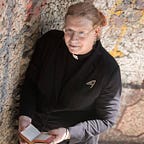Burn Bright the Light — Summer Solstice Sermon, 2020
Ate wiokpeyata, nawajin yelo, wayamakan yo-
Ite, oh Tate ya, nawajin yelo, hey, nawjin yelo
(Translation from the Lakota: “Grandfather in the West, I am raising my voice in prayer. I stand, alone, the wind blowing in my face, waiting for your answer to my prayer.” )
This opening line to a 2009 sermon by the Rev. Howard Anderson, as he talked about the intersection of discerning his call to ordination in the Episcopal tradition in 1985, on one of three traditional Lakota hanblechyas Rev. Anderson undertook, prior to his eventual surrender to the inevitable Spirit. As it is said in Indian country, these things have a way of working themselves out the way they should.
Around the time that Rev. Anderson was preaching his sermon in Pacific Palisades, California, I was sitting on a blanket on top of a hill, holding my chanupa wakan, shivering and wondering just what I had gotten myself into. Three days, three nights, in June, about an hour south east of here, actually.
There was lots of sun. Wasn’t supposed to be.
There was lots of heat. Wasn’t supposed to be.
The hanblecheya is not easy. It’s not supposed to be.
The hanblecheya is suffering. It’s supposed to be.
There was lots of crying and praying. Definitely supposed to be.
Speaking of supposed to be, I was supposed to be in South Dakota for my hanbleycha, on ground owned by family of friends. But things happened, and the Badlands came to me. I sang and prayed, just I would have in South Dakota, and guess what? Spirit don’t care:
Ate wiokpeyata, nawajin yelo,
wayamakan yo, Ite, oh Tate ya,
nawajin yelo, hey, nawjin yelo.
Things, they say, have a way of working themselves out the way they should.
I mark the solstice each year by revisiting my hanbleycha, for truths I’ve come to know, and lessons I can teach. One of those truths is that, in this moment of longest light and purest stillness, we still look too much for what’s in front of us. The poet Elizabeth Barret Browning wrote it better than I can, “Earth’s crammed with heaven, and every common bush is afire with God, but only he who sees takes off his shoes; the rest sit around it and pluck blackberries.”
One memory I always come back to is that of the tajúnska oyate, the ant nation. Tajúnska are often seen as warriors because of their fearlessness, tenacity, and painful bites. I can confirm the validity of all three. During my time “on the hill”, the ant nation and I had a number of discussions about the best way to co-exist. We were not always speaking the same language.
But one time we did. We communicated, and the lesson to me was clear- stay away. I was not an ant, and I did not belong to the ant nation. But I could learn: Move, lift, store, build, protect, grow, live, again. A pattern, with jobs, controlled and executed by instinct and with purpose, but always in relationship. Even when competition was evident, cooperation and relationship sat at the heart of it.
Move, lift, store, build, protect, grow, live, again. The cycle repeats, the colony thrives. Covenantally.
Things, they say, have a way of working themselves out.
When solstice comes around, the work Springtime is evident everywhere we examine. The season of reaping is coming, and a moment of resting and waiting, the season of summer, is now.
Summer, summa, summa- the assembly, massing, building, growing, maturing phase of a project, argument, or year. Summer is our hottest (temperature-wise) season, one only getting worse as we fail to rise to the challenges of global warming, suburban sprawl, institutional racism, indigenous genocide, the list goes on.
The work is ours to do.
The call is ours to answer.
There is no shadow cast for us to hide in: it is us who must answer, who must work, who must do.
We have a glorious vision of the Beloved Community, passed down generationally, and it is not easy, the quest to get there is hard. Understanding it has, for many of us, become a sort of cultural appropriative hanblecheya.
Let me pause for a second.
Hanbleycha is often mistranslated as “vision quest”. This is wrong.
The closest English equivalent of the word is actually “crying for a vision”, but crying, in this context, means more than that, it means the on-the-ground, wringing-your-heart-out, tears-streaming-down-your-face, all-encompassing-desire, crying with that lamenting desperate prayer of “HOW LONG, SPIRIT, HOW LONG MUST WE WAIT AND WORK FOR THIS” is ripped,
broken-voiced and rasping from your throat.
That, friends, is hanblecheya.
Do that, to the gods, or God, for four days and four nights, with no food and no water, while being supported by your community as a rite of passage or for a way to help lead your community. That is hanblecheya. Our desire for the Beloved Community must be that strong, that deep, that woven into our identity. It must become the language of our songs without becoming the songs of our language. Not the ritual- that doesn’t belong to us, but the need, the want, the desire, that does, and should.
It was the prayer that Rev. Anderson sang in 1985 in the Black Hills, the same prayer I sang twenty-five years later.
It is the same prayer that I can feel rising on this solstice morning, rising like a beacon of light, illuminating the way to the Beloved Community, a veritable pillar of fire to guide our path.
Can you feel it? Can you hear it? Can you see it?
It’s here, whispering around us,
breathing with us,
begging us to join in the refrain:
Burn Bright the Light: Let Love’s truth ignite!
Burn Bright the Light: Let Love’s truth ignite!
Selah, aho, and blessed be, beloveds!
